Six authentic wartime recipes to celebrate VE Day, from Lord Woolton's pie to 'Surprise Potato Balls'
Wartime recipes exhibited incredibly ingenuity with limited ingredients — here are six of the best.
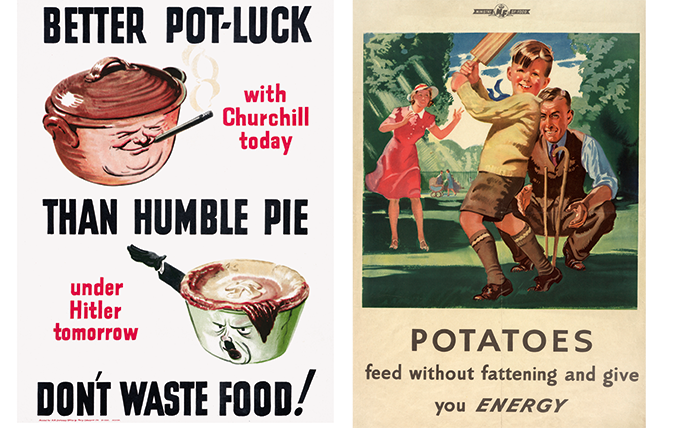
If you're looking for a way to mark VE Day this weekend, these recipes extracted from the Imperial War Museum's Victory in the Kitchen (Published by the museum, £6.99) are perfect.
We initially ran these recipes with kind permission of the museum when the book was first published, but this seems the ideal time to revisit them — and we'd also recommend these articles discussing some of the tales to be be found in the book: The recipes that kept Britain going, How Potato Pete helped Britain take on Hitler and How the carrot helped Britain win the Second World War.
Recipe: Lord Woolton’s Pie
For a nation that favoured meat, it was extraordinary for a vegetarian dish to be accepted by the British people. Lord Woolton’s Pie is an example of a dish that was so successful, it in fact became a legendary wartime recipe. As overseas supplies became increasingly threatened by the war, there was a push towards home-grown produce and self-sufficiency.
That need led to the creation of this pie, one of the most popular wartime recipes, which was named after the wartime Minister of Food. It’s a root vegetable pie, including the infamous ‘Doctor Carrot’ and ‘Potato Pete,’ blended with oats and topped with a potato crust.
Ingredients
For the filling
- 1lb seasonal vegetables such as potato, swede, cauliflower and carrot
- 3–4 spring onions
- 1 teaspoon vegetable extract
- 1 tablespoon oatmeal
- Chopped parsley
For the pastry
- 8oz wheatmeal flour
- 1 level teaspoon baking powder
- Pinch of salt
- Pinch of powdered sage (optional)
- 1 pint cold milk, or milk and water
Method
Dice the vegetables and spring onions. Cook together with the vegetable extract and oatmeal for 10 minutes with just enough water to cover. Stir occasionally to prevent the mixture from sticking. Allow to cool.
Sign up for the Country Life Newsletter
Exquisite houses, the beauty of Nature, and how to get the most from your life, straight to your inbox.
To make the pastry, mix all the dry ingredients together then stir in the milk milk and water, and roll out the mixture.
Finally, put the filling in a pie dish and sprinkle with chopped parsley, then cover with the pastry. Bake in a moderate oven until the pastry is nicely brown and serve hot with brown gravy.
Recipe: Egg and Bacon Pie
If veggie pie doesn’t appeal to your taste buds, why not try an Egg and Bacon Pie? Two of Britain’s favourite breakfast ingredients mixed together and topped with pastry, what more could one want?
Ingredients
- 2 eggs
- 2–3 oz bacon, chopped
- 1 oz fresh breadcrumbs
- 1 tablespoon milk
- Salt and pepper to taste
- Pastry (as per Lord Woolton's pie, above) using 6oz flour
Method
Line a seven-inch flan ring or sandwich tin with two-thirds of the pastry. Beat the eggs and mix in the bacon, breadcrumbs, milk and seasoning.
Pour into the flan case and cover with the remaining pastry. Bake in a hot oven for an hour and serve hot or cold.
Recipe: Surprise Potato Balls
This playfully named recipe most certainly makes an otherwise rather ordinary potato become that little bit more appealing, especially in wartime Britain. This is simply a wartime take on the well-loved potato croquet.
Ingredients
- 1 lb cooked potato
- 1 large carrot, grated
- 1 teaspoon chopped parsley
- A little sweet pickle
- Salt and pepper
- A few teaspoons of milk, if necessary
- Browned breadcrumbs
Method
Cook the potatoes and beat them well with a fork. Add the grated carrot, parsley, salt and pepper. Use a little milk, if necessary, to bind the mixture, but do not make it wet. Form into balls.
Make a hole in each ball, drop in a small spoonful of pickle and close the hole. Roll in the breadcrumbs, place on a greased baking sheet, and cover with a margarine paper. Bake in a really hot oven for 15–20 minutes. Serve piping hot with good gravy.
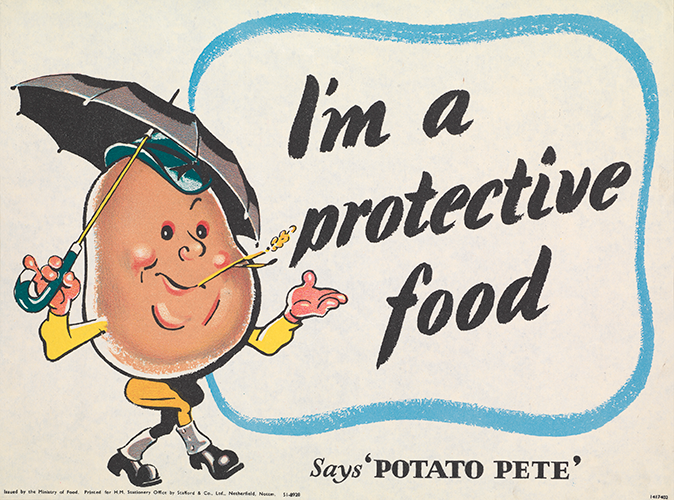
Recipe: Potato Piglets
This recipe combines potato and sausage meat to produce the perfect ‘Potato Piglet.’ The Ministry of Food, set up during the First World War, dedicated time to promote the health benefits of a wartime diet, and vegetables were regarded as the saviour of the wartime family. The ‘Potato Piglets’ recipe also serves as a compelling reminder about the importance of not wasting food during the war.
Ingredients
- 6 medium well-scrubbed potatoes
- Cooked cabbage, lightly chopped
- 6 skinned sausages
Method
Remove a centre core, using an apple corer, from the length of each potato, and stuff the cavity with sausage meat. Bake in the usual way and arrange the piglets on a bed of cooked cabbage. (The potato removed from each is useful for soup.)
Recipe: Carrot Croquets
With sugar being rationed, the Ministry for Food encouraged the use of carrots as sweeteners. For a slightly sweeter take on the traditional potato croquet, try this carrot alternative.
Ingredients
- 12 oz finely grated carrot, raw
- 6 oz finely grated potato, raw
- 4 oz grated cheese
- 1½ teaspoons salt
- Pepper
- ½ teaspoon dry mustard
- 3 oz oatmeal
Method
Mix the finely grated vegetables and cheese. Season, add the oatmeal to form a fairly stiff mixture. Form into croquettes and fry in hot fat.
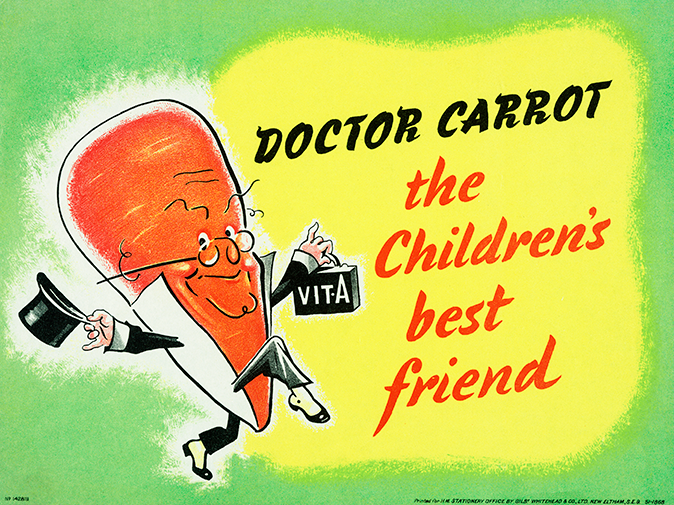
Recipe: Chocolate and carrot pudding
The name might put you off, but is it really any stranger than carrot cake? Of course not, and the success of sweet carrot recipes in the war shows why. Carrots were used in everything from jam sponges to marmalade (dubbed ‘Carrolade’).
Ingredients
- 2 cups flour
- 1 cup grated carrot
- 1 oz sugar
- 2 tablespoons golden syrup
- 1 teaspoon bicarbonate soda
- 1 teaspoon baking powder
- 1 heaped tablespoon cocoa
- ¼ pint milk
- 2 oz margarine
- A little vanilla essence
- Salt
Method
Cream the margarine and sugar together and stir in the grated carrot, syrup, fruit and the rest of the dry ingredients. Add milk to mix to a fairly stiff consistency. Put into a greased basin and steam for 2 hours.
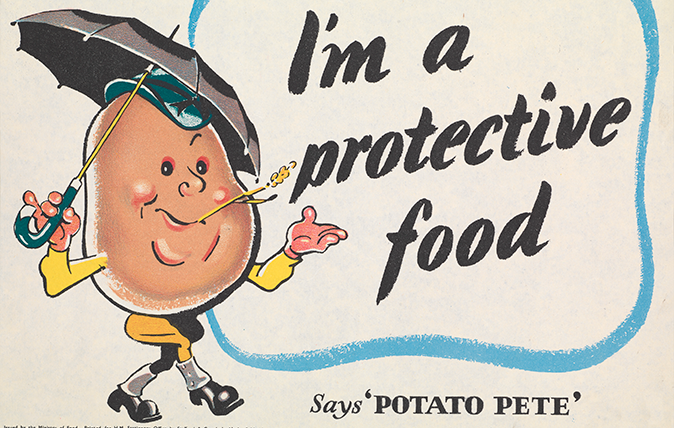
Victory in the Kitchen: How ‘Potato Pete’ helped Britain take on Hitler
'Potato Pete' became one of the most popular characters in Britain's 'Dig for Victory' campaign.

Victory in the Kitchen: The recipes that kept Britain going in the Second World War
You too can rustle up something delicious out of meagre rations with these austerity recipes.
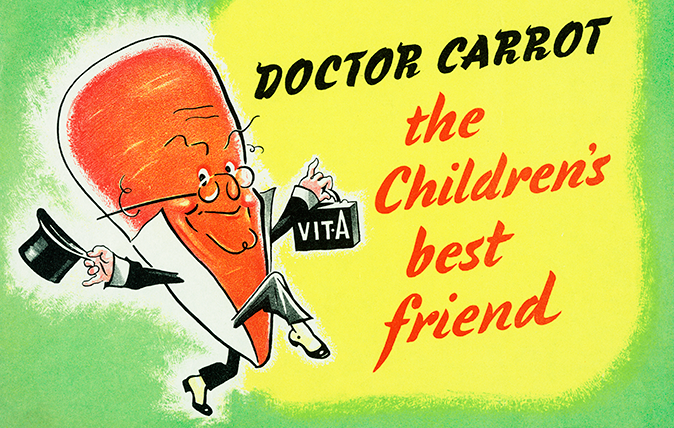
Victory in the Kitchen: How the carrot helped Britain win the Second World War
Britain's ingenuity in the wartime extended to the kitchen, and there's no better example of this than the humble carrot.
Toby Keel is Country Life's Digital Director, and has been running the website and social media channels since 2016. A former sports journalist, he writes about property, cars, lifestyle, travel, nature.
-
 'It was like Fawlty Towers at first': How diversification keeps the country house standing
'It was like Fawlty Towers at first': How diversification keeps the country house standingFrom festivals and car shows, to spas and wedding venues, country house owners are getting creative to keep their estates alive.
-
 The world is your oyster and here is the pearl: How to spend £100,000 on a holiday
The world is your oyster and here is the pearl: How to spend £100,000 on a holidayBig budget travel is on the rise. Here's why, and how to do it properly.
